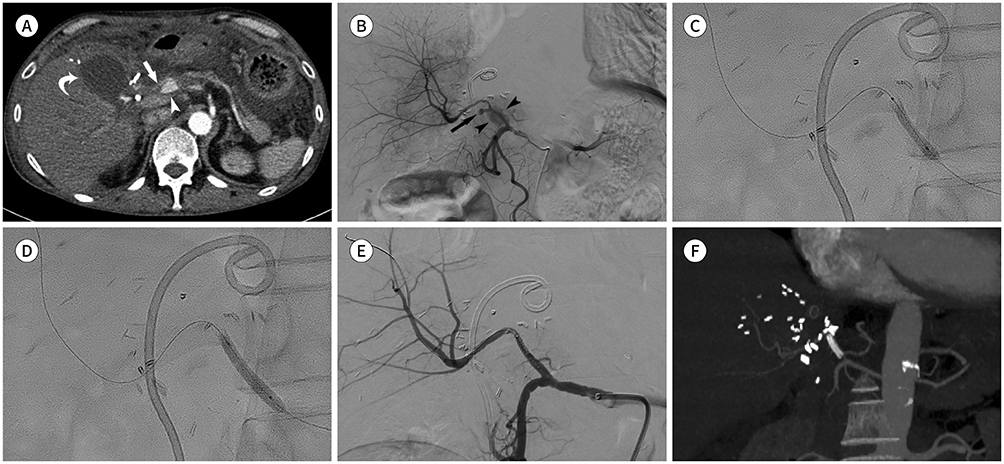J Korean Soc Radiol.
2019 May;80(3):555-561. 10.3348/jksr.2019.80.3.555.
Endovascular Exclusion of Hepatic Artery Pseudoaneurysm after Living-Donor Liver Transplantation with a Stent-Graft Using Conical Remodeling: A Case Report
- Affiliations
-
- 1Department of Radiology, Daegu Catholic University Medical Center, Catholic University of Daegu College of Medicine, Daegu, Korea. urkang@cu.ac.kr
- KMID: 2454035
- DOI: http://doi.org/10.3348/jksr.2019.80.3.555
Abstract
- Hepatic artery complications after liver transplantation include hepatic artery thrombosis, stenosis, pseudoaneurysm (PA), and others. Among these complications, hepatic artery PA is reported to have a low incidence, but it is associated with a devastating and often fatal outcome and a high risk of rupture. Herein, we present the case of a 56-year-old male patient who underwent living-donor liver transplantation because of alcoholic liver cirrhosis. A silent PA of the hepatic artery proper was detected incidentally on computed tomography scan during routine follow-up 15 days after surgery, and was successfully excluded by implantation of a coronary balloon-expandable stent-graft using "˜conical remodeling' by two-step ballooning. This technique can be effectively used for PA of visceral arteries with tapering-small diameter, in which flow preservation is critical to patient care.
MeSH Terms
Figure
Reference
-
1. Marshall MM, Muiesan P, Srinivasan P, Kane PA, Rela M, Heaton ND, et al. Hepatic artery pseudoaneurysms following liver transplantation: incidence, presenting features and management. Clin Radiol. 2001; 56:579–587.
Article2. Saad WE, Dasgupta N, Lippert AJ, Turba UC, Davies MG, Kumer S, et al. Extrahepatic pseudoaneurysms and ruptures of the hepatic artery in liver transplant recipients: endovascular management and a new iatrogenic etiology. Cardiovasc Intervent Radiol. 2013; 36:118–127.
Article3. Muraoka N, Uematsu H, Kinoshita K, Takeda T, Morita N, Matsunami H, et al. Covered coronary stent graft in the treatment of hepatic artery pseudoaneurysm after liver transplantation. J Vasc Interv Radiol. 2005; 16:300–302.
Article4. Elias G, Rastellini C, Nsier H, Nazarey P, Brown M, Pahari M, et al. Successful long-term repair of hepatic artery pseudoaneurysm following liver transplantation with primary stent-grafting. Liver Transpl. 2007; 13:1346–1348.
Article5. Hamby BA, Ramirez DE, Loss GE, Bazan HA, Smith TA, Bluth E, et al. Endovascular treatment of hepatic artery stenosis after liver transplantation. J Vasc Surg. 2013; 57:1067–1072.
Article6. Saxon RR, Chervu A, Jones PA, Bajwa TK, Gable DR, Soukas PA, et al. Heparin-bonded, expanded polytetrafluoroethylene-lined stent graft in the treatment of femoropopliteal artery disease: 1-year results of the VIPER (Viabahn Endoprosthesis with Heparin Bioactive Surface in the Treatment of Superficial Femoral Artery Obstructive Disease) trial. J Vasc Interv Radiol. 2013; 24:165–173. quiz 174.
Article7. Amblard A, Berre HW, Bou-Saïd B, Brunet M. Analysis of type I endoleaks in a stented abdominal aortic aneurysm. Med Eng Phys. 2009; 31:27–33.
Article8. Lu NN, Huang Q, Wang JF, Wei BJ, Gao K, Zhai RY. Treatment of post-liver transplant hepatic artery pseudoaneurysm with balloon angioplasty after failed stent graft placement. Clin Res Hepatol Gastroenterol. 2012; 36:e109–e113.
Article9. Gamanagatti S, Thingujam U, Garg P, Nongthombam S, Dash NR. Endoscopic ultrasound guided thrombin injection of angiographically occult pancreatitis associated visceral artery pseudoaneurysms: case series. World J Gastrointest Endosc. 2015; 7:1107–1113.
Article10. Rastogi N, Williams G, Alencar H. Modality-specific occult intrarenal pseudoaneurysm in a renal allograft and the legacy of catheter angiography. Ann Vasc Surg. 2013; 27:1184.e7–1184.e11.
Article
- Full Text Links
- Actions
-
Cited
- CITED
-
- Close
- Share
- Similar articles
-
- Jejunal Migration of the Stent-Graft Used for Common Hepatic Artery Pseudoaneurysm
- Hepatic Artery Reconstruction Using the Right Gastroepiploic Artery for Hepatic Artery Inflow in a Living Donor Liver Transplantation
- Salvage aorto-hepatic jump graft for hepatic artery thrombosis following living donor liver transplantation: a case report with 10-year follow-up
- Salvage aorto-hepatic jump graft for hepatic artery thrombosis following living donor liver transplantation: a case report with 10-year follow-up
- Successful Management of Splenic Artery Steal Syndrome after Living Donor Liver Transplantation


